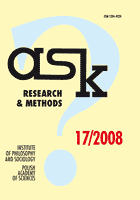How Can We Account for Intersectionality in Quantitative Analysis of Survey Data? Empirical Illustration for Central and Eastern Europe
How Can We Account for Intersectionality in Quantitative Analysis of Survey Data? Empirical Illustration for Central and Eastern Europe
Author(s): Joshua Kjerulf DubrowSubject(s): Social Sciences
Published by: Instytut Filozofii i Socjologii Polskiej Akademii Nauk
Keywords: intersectionality; gender; ethnicity; social class; methods; interaction terms
Summary/Abstract: Qualitative research in political science and sociology commonly explores intersectionality, but practical methodological guides for the quantitative researcher are few. I examine methodological challenges in testing intersectionality theory by comparing and contrasting two most frequently used statistical approaches to the quantitative analysis of intersectional demographics: the unitary, or additive approach and the multiplicative approach. To illustrate these approaches I use the European Social Survey (2006) and focus on gender, ethnicity, and class, and their intersections, to explain soft political protest in Central and East European countries. Logistic regression with dichotomous explanatory variables, including multiplicative interaction terms and their main effects, is an acceptable way to explore variants of intersectionality theory and related hypotheses regarding cumulative disadvantage. The findings warrant the following guidelines for cross-national quantitative analysis of intersectionality: (1) multiplicative interaction terms are the best available way to measure an intersection as an identity beyond the sum of its parts; (2) because intersectionality frequently calls for more than two variables, care must be taken with the interpretation of main effects and higher and lower order interaction terms; and (3) each intersection has time- and space-specific consequences. Accounting for intersectionality in the quantitative analysis of large cross-national survey data sets is an opportunity to advance the intersectionality paradigm.
Journal: ASK. Research & Methods
- Issue Year: 2008
- Issue No: 17
- Page Range: 85-100
- Page Count: 16
- Language: English

